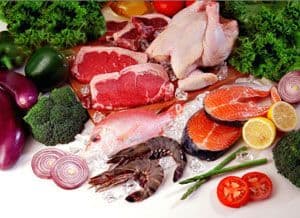Foods Allowed FOR THE Paleo Or Caveman Diet
Paleolithic diet: The Paleolithic diet is a weight loss program based after the premise of eating only those foods available during the Paleolithic era (also called the Stone Era). You can find controversy around whether the Paleolithic diet should be low in saturated animal fats; some authors recommend choosing liver organ to keep saturated excess fat absorption low. Since there is no convincing data that fats are bad, and since fats improve the taste of food, the absorption of nutrients, and make dishes more satisfying, my opinion is the fact the quantity of animal fat included in this diet may be changed to suit specific preferences and purposes.
Methods: In a pooled cross-sectional review of 30- to 74-y-old women and men within an elective outpatient colonoscopy inhabitants (n = 646), we created diet ratings from reactions on Willett food-frequency questionnaires and measured plasma hsCRP and F2-isoprostane concentrations by ELISA and gas chromatography-mass spectrometry, respectively. Both diet results were computed and categorized into quintiles, and their organizations with biomarker concentrations were projected with the use of standard linear models to compute and compare modified geometric means, and via unconditional ordinal logistic regression.
While we all have been familiar with the stereotypes surrounding gender and food - that is, men supposedly favour meat, and women salads and cupcakes - what can cause such choices remains unclear. Is it fitness or biology? It's hard to state. Dr Lucy Cooke, a behavioural psychologist at University or college College London, discovered that boys showed an obvious preference for fatty foods and meat while girls were more willing to eat fruit and vegetables. These dissimilarities became more pronounced in adolescence, indicating that interpersonal conditioning may have a part to play.
Ancient tomatoes were the size of berries; potatoes were no bigger than peanuts. Corn was a outdoors grass, its tooth-cracking kernels borne in clusters no more than pencil erasers. Cucumbers were spiny as sea urchins; lettuce was bitter and prickly. Peas were so starchy and unpalatable that, before eating, they had to be roasted like chestnuts and peeled. The only real available cabbage-the great-great-granddaddy of today's kale, kohlrabi, broccoli, Brussels sprouts, and cauliflower-was sea kale, a hardcore and tongue-curling leafy weed that grew across the temperate sea coasts. Carrots were scrawny. Beans were normally laced with cyanide.
left out no selections or cookbooks. To figure out what they ate, we must find out their bones and study the wear patterns on the teeth. Or comb through their refuse and assess their prehistoric poop. And paleo eating is just the tip of the spear, so to speak. There are excited advocates for paleo fitness, which starts off with tossing out your sneakers. There are a paleo sleep contingent, which recommends blackout curtains, amber-tinted glasses, and getting rid of your mattress; and there are champions of primal parenting, which may or might not exactly include eating your baby's placenta. There are even symptoms of a paleo hygiene motion: coat yourself with bacteria and say goodbye to soap and shampoo.
Methods: In a pooled cross-sectional review of 30- to 74-y-old women and men within an elective outpatient colonoscopy inhabitants (n = 646), we created diet ratings from reactions on Willett food-frequency questionnaires and measured plasma hsCRP and F2-isoprostane concentrations by ELISA and gas chromatography-mass spectrometry, respectively. Both diet results were computed and categorized into quintiles, and their organizations with biomarker concentrations were projected with the use of standard linear models to compute and compare modified geometric means, and via unconditional ordinal logistic regression.
While we all have been familiar with the stereotypes surrounding gender and food - that is, men supposedly favour meat, and women salads and cupcakes - what can cause such choices remains unclear. Is it fitness or biology? It's hard to state. Dr Lucy Cooke, a behavioural psychologist at University or college College London, discovered that boys showed an obvious preference for fatty foods and meat while girls were more willing to eat fruit and vegetables. These dissimilarities became more pronounced in adolescence, indicating that interpersonal conditioning may have a part to play.
Ancient tomatoes were the size of berries; potatoes were no bigger than peanuts. Corn was a outdoors grass, its tooth-cracking kernels borne in clusters no more than pencil erasers. Cucumbers were spiny as sea urchins; lettuce was bitter and prickly. Peas were so starchy and unpalatable that, before eating, they had to be roasted like chestnuts and peeled. The only real available cabbage-the great-great-granddaddy of today's kale, kohlrabi, broccoli, Brussels sprouts, and cauliflower-was sea kale, a hardcore and tongue-curling leafy weed that grew across the temperate sea coasts. Carrots were scrawny. Beans were normally laced with cyanide.
left out no selections or cookbooks. To figure out what they ate, we must find out their bones and study the wear patterns on the teeth. Or comb through their refuse and assess their prehistoric poop. And paleo eating is just the tip of the spear, so to speak. There are excited advocates for paleo fitness, which starts off with tossing out your sneakers. There are a paleo sleep contingent, which recommends blackout curtains, amber-tinted glasses, and getting rid of your mattress; and there are champions of primal parenting, which may or might not exactly include eating your baby's placenta. There are even symptoms of a paleo hygiene motion: coat yourself with bacteria and say goodbye to soap and shampoo.
